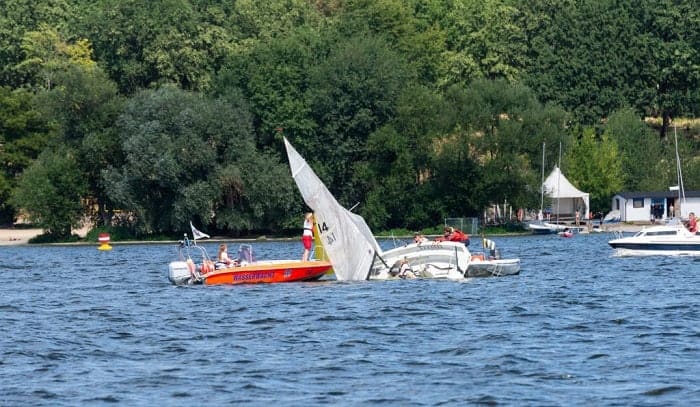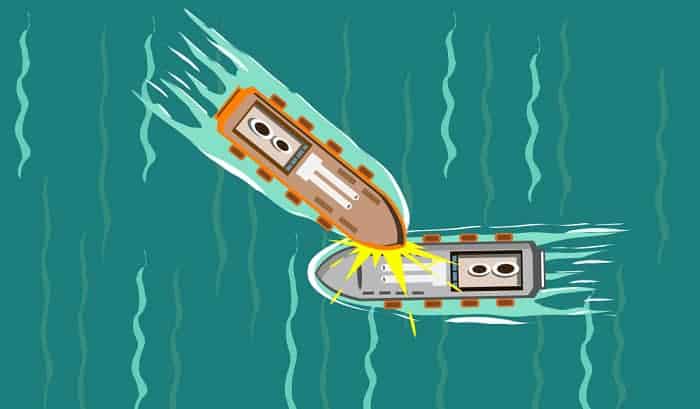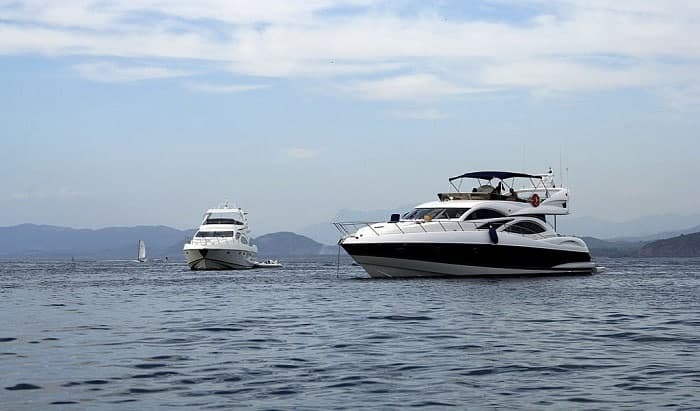Observing marine traffic is one of the safety measures that you have to learn when sailing. Accidents can happen and it’s the last thing that you never wanted from your water adventures.
Hence, what should you do to avoid colliding with another boat? You have to know the rules of navigating a boat and the right moves in certain situations. The essential techniques are discussed in this article to educate you further.
Continue reading if you want to handle your boat safely. Once you know how to maneuver your boat properly, chances of water accidents will be minimized.
Table of Contents
- Navigation Rules For Different Kinds Of Water Vessels
- List Of Aids To Navigation
- What You Should Do to Avoid Colliding with Another Boat
- 1. Always on the Watch
- 2. Away from Shipping Lanes
- 3. Know What Speed is All About
- 4. Maintaining Your Visibility
- 5. Operating VHF Radio When Underway
- 6. Only Sail When You’re Sober
- 7. Be Prepared for the Unexpected
- 8. Know How to Control the Speed
- 9. Using Common Sense and Being Boat Smart
- 10. Using Sound Signals
- Final Words
Navigation rules are akin to the ones that are imposed on the road. No collision will occur if everyone follows them. To be aware of the water regulations, you have to be familiar with the important terms first. Hence, you have to know them.
- Stern – the rear part of a vessel
- Portside – the left side of the vessel when you’re looking at the bow
- Starboard – the right side of the vessel when you’re looking at the bow
- Stand-on vessel – maintains the course and speed
- Give-way vessel – moves to avoid stand-on vessel
You should know these words before you learn the rules. They will help you easily understand every step along the way and avoid clashing with other boats.
When two vessels tend to intersect when moving in a straight course, these two rules apply:
- You’re the stand-on vessel when you’re approaching another boat on the starboard side. Thereby, you can keep the course.
- If you’re on the port side, the other boat is the stand-on vessel. Expect the other to keep the course while you avoid it as you give way.
When a vessel overtakes another, observe these things:
- A boat that intends to overtake is called a give-way vessel; thus, the others are called stand-on vessels.
- The give-way vessel should take the necessary actions to avoid the stand-on vessel, which maintains its course and speed.
- The give-way vessel has the right to overtake the other vessel from any side. Use one short sound signal when overtaking on the starboard side. When overtaking on the port side of another craft, two short sound signals should be executed.
A response should be given by the boat that was overtaken in the form of the same sound signal.
For two vessels that come face to face head-on, these things should be practiced:
- Both should pass through the port side.
- Both should be responsible for avoiding clashing with each other.
An encounter of Two Motorized Vessels
The mentioned above overtaking and crossing applies in this scenario between two motorized boats. It’s simply the meeting of two motorized vessels and the way is given to the one on the starboard side.
An encounter of a Motorized Vessel and Sailboat
The sailboat is always the stand-on vessel over the motorized boat, which has the role in giving way to the former. In a different situation, a sailboat is perceived as the give-way vessel when overtaking another vessel.
It will be the same practice in a narrow channel as it will be hard for a motorboat to move easily.
An encounter of Two Sailboats
Wind direction is important for sailboats to move around the waters safely. These are the regulations when two sailboats meet:
- The give-way vessel between the two sailboats is the one with the wind on the port side.
- The stand-on vessel is the sailboat with the wind on the starboard side.
- If ever the two sailboats have the wind on the same side, the give-way vessel is the one that is nearest to the air. On the other hand, the one that is farthest from the blowing wind is the stand-on vessel.
Some vessels are always on the right of way over motorized vessels but not maneuverable. They are as follows:
Broken boats, Canoes, Commercial Fishing Boats, Kayaks, Rowing Boats, Sailboats, Towing boats
You can break the navigation rules right off the bat based on your wise judgment. If you’re in doubt, you may give way to the other vessel as this action ensures that no collision will happen.
ATONS, short for ‘Aids To Navigation’, are items that help safe navigation over bodies of water. They are tools for electronic signals, visibility, and the auditory sense. Every boater should know and understand their functions. Some of them are the following:
Buoys, Day Beacons, Fog Signals, Lights, Lightships, Lighthouses, Marks, Radio Beacons
What You Should Do to Avoid Colliding with Another Boat
1. Always on the Watch
Someone should always be on the watch for other vessels, upcoming hazards, people around, and navigation aids. This is very significant in times of low visibility at night and foggy areas. Thus, binoculars will come in handy.
2. Away from Shipping Lanes
Shipping lanes are the course for large crafts that carry cargo. You’ll see them marked as magenta swaths on charts. The lanes are five miles wide and the traffic lanes are up and down-stream.
While it will take for sailboats to cross these lanes of five miles, an enormous ship can pass through it way faster. It’s still vital to stay away from a 90-degree angle. Never think of anchoring, fishing, or halting on shipping lanes.
3. Know What Speed is All About
Ships cruise at an average of 30 knots. Based on this fact, you should know that it can take a large ship only 15 minutes to arrive at your location from the horizon. With imposing danger, never overtake a crossing vessel.
When you’re not sure that you can get into the other side before the ship reaches, turn a bit to position your boat behind them. It’s a polite move and most of all, safe!
4. Maintaining Your Visibility
Small crafts are hard to see at night and foggy areas. It may not be visible from the ship’s deck too. Here’s what you can do:
- Running lights should be powered up around the clock. Even when your boat is anchored, you have to put up the right light system.
- A radar reflector is a big help too for other radars to pick up your presence. You can add AIS or Automatic Identification System capability to your equipment.
- According to the US Coast Guard, show a distress signal by using a strobe light.
5. Operating VHF Radio When Underway
While moving on the waters, you must turn on the VHF radio. Set the hailing frequency and distress while on Channel 16. It’s the correct mode in case when someone is trying to reach out to you.
Others may call you a ‘fishing boat off my port bow’ as they don’t know you. When you’ve connected with someone and wish to continue the communication, switch to another available frequency.
6. Only Sail When You’re Sober
Fatigue and sleepiness cause disaster in any activity like sailing. Don’t sail when you’re not in good condition because you’re only putting yourself in danger.
7. Be Prepared for the Unexpected
Be vigilant and choose to move slowly when you’re sailing in the early morning or late afternoon. They are the time of the day with dazzling reflection on the water. Also, keep an eye on logs or some objects in coastal areas, lakes, and rivers.
8. Know How to Control the Speed
Always slow down in low visibility areas and no-wake zones. Swimming areas are marked by ropes so be responsible enough to check if some people are around.
Congested piers are filled with large watercraft that are docking and leaving. See to it that you remain on the clearing as the prop wash of those vessels can form turbulence which can rob you of your control over your boat.
9. Using Common Sense and Being Boat Smart
Safe boating and fun boating can always be done at the same time. Just follow these steps:
- Don’t do towing sports on navigation channels or swimming areas.
- Before turning, look in all directions, including what’s behind you.
- Make it a habit to keep clear as you can’t assume that all boaters know that what they’re doing is right. Always practice evasive measures.
10. Using Sound Signals
Here are the sound signals and their implication:
- A blast that lasts for a second (Passing on the port side)
- Two, short blasts (Passing on the starboard)
- Three, short blasts (The engine is placed in reverse.)
- Five, short blasts (Means danger; the intention of the incoming boat is undetermined)
- Prolonged blast that goes for four to six seconds (When entering and leaving obstructed sections)
- Prolonged blast every two minutes (the motorized vessel is moving in low visibility area)
- A single prolonged blast and two short blasts every two minutes (sailboat is crossing low visibility area)
Final Words
What should you do to avoid colliding with another boat? For the sake of safety when sailing, you should know how to control your boat. Avoiding collisions and accidents is in your hands. Thus, as a boat owner, you should know the signs and give way to other vessels.
By observing water regulations, everyone will enjoy the waterways. Only fun memories will be created rather than summing up the number of incidents.

“I am James Harvey – founder of Boating Basics Online. It is established with the drive to help out first-time boaters, which are those desiring to explore their way through the water. So if you are new to boating, start from here with me. “



